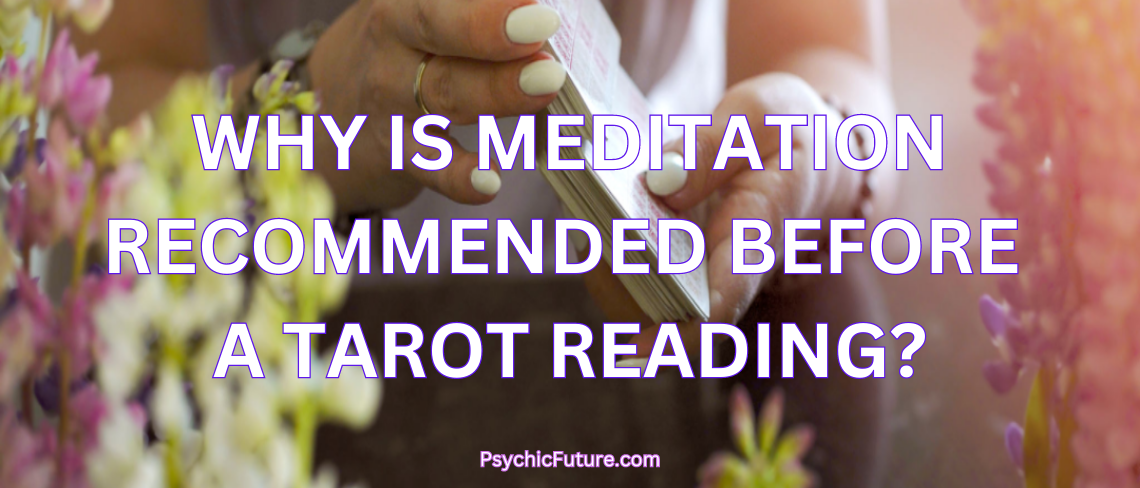Tarot, a centuries-old practice with roots in the Italian Renaissance, has experienced a resounding resurgence in modern culture. Not just a mystical tool but a path to self-discovery and personal growth, Tarot allows us to connect with our inner selves and seek guidance in life’s complexities.
One crucial aspect of this practice is meditation. But why is it recommended before a Tarot reading? Grab a comforting cup of tea and settle in as we journey into the mystical realm of Tarot and meditation, and discover their harmonious bond.
To unravel this celestial conundrum, let’s look at an analogy. Consider the Tarot deck as a magical forest. Each card is a unique tree, with its own story and energy. Venturing into this forest without preparing oneself may cause us to miss essential cues, paths, or messages from the trees. Meditation, in this case, is the guide that helps us to tune into the forest’s spirit and appreciate its wisdom fully.
Renowned Tarot reader and author, Mary K. Greer, emphasises the importance of meditation in her book “Tarot for Your Self” by saying, “Meditation before a Tarot reading is like opening the doors to the library of your subconscious. It helps you to access the deep-seated knowledge within.” (Greer, 1984).
Meditation, in essence, is a practice of stilling the mind and body to achieve a state of heightened awareness and focus. It allows us to declutter our minds and attune our senses to subtle energies, creating an ideal mental space for interpreting the symbolic language of Tarot.
The process of meditation before a Tarot reading serves several crucial functions:
Quieting the Mind
In our fast-paced lives, our minds are constantly buzzing with thoughts, to-dos, and sensory input. This mental chatter can cloud our intuition and affect our ability to interpret the Tarot cards effectively. A simple five to ten-minute meditation session can help silence this chatter and create a calm mental space. When the mind is tranquil, our intuitive faculties can emerge, enhancing the quality of the Tarot reading.
Connecting with the Self
At its core, Tarot is a tool for introspection. The cards serve as mirrors, reflecting our inner selves and the lessons we need to learn. Meditation fosters this self-connection, helping us to align with our intuition and authentic self. This alignment can allow for a more profound and personal interpretation of the cards.
Energising the Cards
Meditation is also an effective way to cleanse and energise your Tarot deck. Holding the deck in your hands while meditating allows your energy to infuse the cards, aligning them with your unique vibrational signature.
Setting the Intention
Meditation provides a sacred space to set your intention for the reading. Whether you seek guidance on a specific issue or general direction, focusing your intention during meditation helps to direct the reading’s energy. This intent acts like a compass, pointing the Tarot cards towards the insights you seek.
Tips for Meditative Tarot Practice
Here are some practical tips to integrate meditation into your Tarot practice:
Begin with simple breathing exercises: Start your meditation practice by focusing on your breath. Breathe in slowly and deeply, hold for a moment, then exhale with the same deliberate pace. This practice helps to centre the mind and body.
Set a calm and comforting environment: Make sure your reading space is comfortable and inviting. Lighting a candle or incense, dimming the lights, or playing soothing music can all help to create a calming atmosphere conducive to meditation.
Try guided meditations: If you’re new to meditation, guided meditations can be a great place to start. There are various online resources offering free guided meditations specifically designed for Tarot readings.
Don’t rush: Remember, meditation is not a race. It’s okay if you can only meditate for a few minutes at first. With time, your ability to maintain focus will naturally increase.
So, next time you reach for your Tarot deck, take a moment to meditate. Not only will it enhance your reading, but it also may uncover deeper insights and provide a more rewarding Tarot experience. In the end, the quieting of the mind, the connection with the self, and the setting of intention allows for a greater understanding and interpretation of the Tarot’s wisdom.
References:
- Greer, M. K. (1984). Tarot for Your Self: A Workbook for Personal Transformation. Newcastle Publishing Company.



